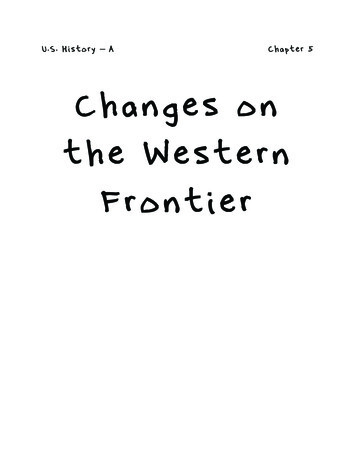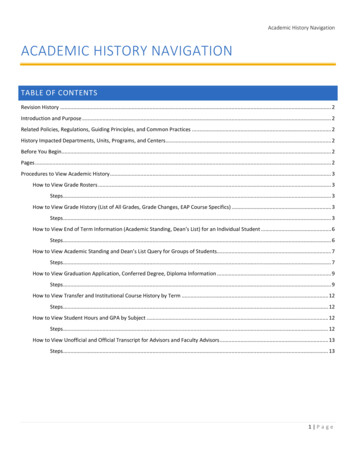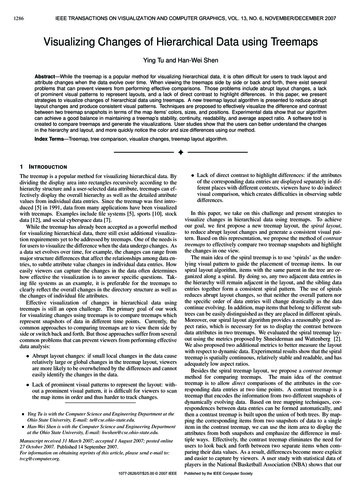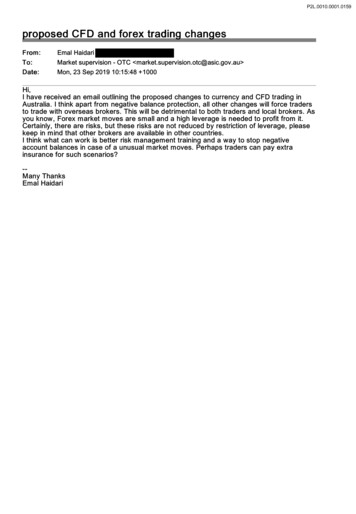
Transcription
U.S. History – AChapter 5Changes onthe WesternFrontier
200-201-Chapter 510/21/024:53 PMPage 200Page 1 of 2Until the 1860s, the migratory Indians of Montana—including the Blackfeet shown here—followed the buffaloherds and traded peacefully with whites in the region.1870 Red Cloud,chief of the OglalaSioux, states hispeople's case inWashington, D.C.USAWORLD18701869 SuezCanal is opened.2001880 JamesGarfield iselectedpresident.CHAPTER 51884GroverClevelandis electedpresident.1881 Garfield isassassinated.Chester Arthurbecomes president.18801872 Secretballot isadopted inBritain.1881 Frenchoccupy Tunisia.
200-201-Chapter 510/21/024:53 PMPage 201Page 2 of 2INTERACTWI T HHI S T O RYIt is the late 1890s. The AmericanWest is the last frontier. Ranchers,cowboys, and miners have changedforever the lives of the Native Americans who hunted on the Westernplains. Now westward fever intensifiesas “boomers” rush to grab “free” farmland with the government’s blessing.What do youexpect to findon settling inthe West?Examine the Issues What might be some ways to makea living on the Western frontier? If native peoples already live inyour intended home, how willyou co-exist? How might settlers and NativeAmericans differ regarding useof the land?RESEARCH LINKSCLASSZONE.COMVisit the Chapter 5 links for more informationabout Changes on the Western Frontier.1889 Oklahomaopened forsettlement; theland rush begins.1890 Siouxare massacredat WoundedKnee.1893Diminished U.S.gold reservetriggers thepanic of 1893.1896 William McKinleyis elected president.1896 William Jennings Bryanruns for president.190018901893France takesoverIndochina.1899 Berlin Conferencedivides Africa amongEuropean nations.1900 BoxerRebellion takesplace in China.Changes on the Western Frontier 201
202-211-Chapter 510/21/024:53 PMPage 202Page 1 of 10Cultures Clash onthe PrairieMAIN IDEAThe cattle industry boomed inthe late 1800s, as theculture of the Plains Indiansdeclined.Terms & NamesWHY IT MATTERS NOWToday, ranchers and PlainsIndians work to preserve theircultural traditions. Great Plains Treaty of FortLaramie Sitting Bull George A. Custer assimilation Dawes Act Battle ofWounded Knee longhorn Chisholm Trail long driveOne American's StoryZitkala-Ša was born a Sioux in 1876. As she grew up on the Great Plains, shelearned the ways of her people. When Zitkala-Ša was eight years old she was sentto a Quaker school in Indiana. Though her mother warned her of the “whitemen’s lies,” Zitkala-Ša was not prepared for the loss of dignity and identity sheexperienced, which was symbolized by the cutting of her hair.A PERSONAL VOICE ZITKALA-ŠA“ I cried aloud . . . and heard them gnaw off one of my thick braids. Then I lost myspirit. Since the day I was taken from my mother I had suffered extreme indignities. . . . And now my long hair was shingled like a coward’s! In my anguish Imoaned for my mother, but no one came. . . . Now I was only one of many littleanimals driven by a herder.”Image notavailable foruse on CDROM. Pleaserefer to theimage in thetextbook.—The School Days of an Indian GirlZitkala-Ša experienced firsthand the clash of two very differentcultures that occurred as ever-growing numbers of white settlersmoved onto the Great Plains. In the resulting struggle, the NativeAmerican way of life was changed forever.The Culture of the Plains IndiansZitkala-Ša knew very little about the world east of the MississippiRiver. Most Easterners knew equally little about the West, picturing avast desert occupied by savage tribes. That view could not have beenmore inaccurate. In fact, distinctive and highly developed Native American waysof life existed on the Great Plains, the grassland extending through the westcentral portion of the United States. (See map on page 205.)202CHAPTER 5A WALK IN TWOWORLDSThe Educationof Zitkala-Ša, aSioux
202-211-Chapter 510/21/024:53 PMPage 203Page 2 of 10To the east, near the lower MissouriRiver, tribes such as the Osage and Iowa had,for more than a century, hunted and planted crops and settled in small villages. Fartherwest, nomadic tribes such as the Sioux andCheyenne gathered wild foods and huntedbuffalo. Peoples of the Plains, abiding bytribal law, traded and produced beautifullycrafted tools and clothing.MAIN IDEASummarizingA How did thehorse influenceNative Americanlife on the GreatPlains?A. AnswerThe horse gavethem increasedmobility, extending their huntingterritory. But thehorse alsosometimes promoted greatercommunication,and sometimesclashes, withother tribes.FAMILY LIFE Native Americans on the plains usually lived in small extendedfamily groups with ties to other bands that spoke the same language. Young mentrained to become hunters and warriors. The women helped butcher the gameand prepared the hides that the men brought back to the camp; young womensometimes chose their own husbands.The Plains Indian tribes believed that powerful spirits controlled events inthe natural world. Men or women who showed particular sensitivity to thespirits became medicine men or women, or shamans. Children learnedproper behavior and culture through stories and myths, games, and goodexamples. Despite their communal way of life, however, no individual wasallowed to dominate the group. The leaders of a tribe ruled by counselrather than by force, and land was held in common for the use of thewhole tribe. Vocabularycoup: a feat ofbravery performedin battleTHE HORSE AND THE BUFFALO Afterthe Spanish brought horses to New Mexicoin 1598, the Native American way of lifebegan to change. As the native peoplesacquired horses—and then guns—they wereable to travel farther and hunt more efficiently. By the mid-1700s, almost all thetribes on the Great Plains had left theirfarms to roam the plains and hunt buffalo.Their increased mobility often led to war when hunters in one tribe trespassed on other tribes’ hunting grounds. For the young men of a tribe, taking partin war parties and raids was a way to win prestige. But a Plains warrior gainedmore honor by “counting coup” than by killing enemies. This practice involvedtouching a live enemy with a coup stick and escaping unharmed. And sometimeswarring tribes would call a truce so that they could trade goods, share news, orenjoy harvest festivals. Native Americans made tepees from buffalo hides and alsoused the skins for clothing, shoes, and blankets. Buffalo meat was dried into jerkyor mixed with berries and fat to make a staple food called pemmican. While thehorse gave Native Americans speed and mobility, the buffalo provided many oftheir basic needs and was central to life on the Plains. (See chart on page 207.) AA portrait of aSioux man andwoman in the late19th century.This YanktonSioux coup stickwas used bywarriors. Settlers Push WestwardThe culture of the white settlers differed in many ways from that of theNative Americans on the plains. Unlike Native Americans, who believedthat land could not be owned, the settlers believed that owning land, making a mining claim, or starting a business would give them a stake in thecountry. They argued that the Native Americans had forfeited their rightsto the land because they hadn’t settled down to “improve” it. Concludingthat the plains were “unsettled,” migrants streamed westward along railroadand wagon trails to claim the land.203
202-211-Chapter 510/21/024:53 PMPage 204Page 3 of 10THE LURE OF SILVER AND GOLD The prospect of striking it rich was one powerful attraction of the West. The discovery of gold in Colorado in 1858 drew tensof thousands of miners to the region.Most mining camps and tiny frontier towns had filthy, ramshackle livingquarters. Rows of tents and shacks with dirt “streets” and wooden sidewalks hadreplaced unspoiled picturesque landscapes. Fortune seekers of every description—including Irish, German, Polish, Chinese, and African-American men—crowded the camps and boomtowns. A few hardy, business-minded women tried theirluck too, working as laundresses, freight haulers, or miners. Cities such as VirginiaCity, Nevada, and Helena, Montana, originated as mining camps on NativeAmerican land.The Government Restricts Native AmericansWhile allowing more settlers to move westward, the arrival of the railroads alsoinfluenced the government’s policy toward the Native Americans who lived onthe plains. In 1834, the federal government had passed anact that designated the entire Great Plains as one enormousreservation, or land set aside for Native American tribes. Inthe 1850s, however, the government changed its policy andcreated treaties that defined specific boundaries for eachtribe. Most Native Americans spurned the governmenttreaties and continued to hunt on their traditional lands,clashing with settlers and miners—with tragic results. BKEY PLAYERSITTING BULL1831–1890As a child, Sitting Bull was knownas Hunkesni, or Slow; he earnedthe name Tatanka Iyotanka(Sitting Bull) after a fight with theCrow, a traditional enemy of theSioux.Sitting Bull led his people bythe strength of his character andpurpose. He was a warrior, spiritual leader, and medicine man,and he was determined thatwhites should leave Sioux territory. His most famous fight wasat the Little Bighorn River. Abouthis opponent, George ArmstrongCuster, he said, “They tell me Imurdered Custer. It is a lie. . . .He was a fool and rode to hisdeath.”After Sitting Bull’s surrender tothe federal government in 1881,his dislike of whites did notchange. He was killed by NativeAmerican police at Standing RockReservation in December 1890.204CHAPTER 5MASSACRE AT SAND CREEK One of the most tragicevents occurred in 1864. Most of the Cheyenne, assumingthey were under the protection of the U.S. government, hadpeacefully returned to Colorado’s Sand Creek Reserve forthe winter. Yet General S. R. Curtis, U.S. Army commanderin the West, sent a telegram to militia colonel JohnChivington that read, “I want no peace till the Indians suffer more.” In response, Chivington and his troops descended on the Cheyenne and Arapaho—about 200 warriors and500 women and children—camped at Sand Creek. Theattack at dawn on November 29, 1864 killed over 150inhabitants, mostly women and children.DEATH ON THE BOZEMAN TRAIL The Bozeman Trailran directly through Sioux hunting grounds in the BighornMountains. The Sioux chief, Red Cloud (Mahpiua Luta),had unsuccessfully appealed to the government to endwhite settlement on the trail. In December 1866, the warrior Crazy Horse ambushed Captain William J. Fettermanand his company at Lodge Trail Ridge. Over 80 soldiers werekilled. Native Americans called this fight the Battle of theHundred Slain. Whites called it the Fetterman Massacre.Skirmishes continued until the government agreed toclose the Bozeman Trail. In return, the Treaty ofFort Laramie, in which the Sioux agreed to live on areservation along the Missouri River, was forced on the leadersof the Sioux in 1868. Sitting Bull (Tatanka Iyotanka),leader of the Hunkpapa Sioux, had never signed it. Althoughthe Ogala and Brule Sioux did sign the treaty, they expectedto continue using their traditional hunting grounds.MAIN IDEAAnalyzingIssuesB What was thegovernment’spolicy towardNative Americanland?B. AnswerThe governmentwanted torestrict allNativeAmericans todesignatedareas.SkillbuilderAnswers1. Little Bighorn,Wounded Knee.2. 1894—about90%; 2000—lessthan 1%.
202-211-Chapter 510/21/024:53 PMPage 205Page 4 of 10Shrinking Native American Lands, and Battle Sites181918942000Area of main mapNWBLACKFOOTK YO C130 Wve40 NCHEYENNELittle unded Knee,1890Fort LaramieBattle site00100200 milesHOPI100 200 kilometers30 NSand CreekMassacre, 1864UTEPAWNEErNAVAJOiv eIndian AGrRi oGEOGRAPHY SKILLBUILDER1. Location Which battles took place onanNative American land?rrRiveadoColorGreat PlainsSIOUXR iv esouriMisUTEA I N SU N TM OPACIFICOCEANFetterman Massacre,1866ILTRASHOSHONEANiSn a k e RSHASTASIOUXiRSRNEZ PERCEMississip pEde2. Movement About what percentage ofNative American lands had the government taken over by 1894?A Sioux encampment near the120 WSouth Dakota-Nebraska border.110 W90 W
202-211-Chapter 510/21/024:53 PMPage 206Page 5 of 10Bloody Battles ContinueThe Treaty of Fort Laramie provided only a temporary halt to warfare.The conflict between the two cultures continued as settlers moved westward and Native American nations resisted the restrictions imposed uponthem. A Sioux warrior explained why.The Winchester’76 rifle used bygovernmenttroops, and aSioux war bow. A PERSONAL VOICE GALL, A HUNKPAPA SIOUX“ [We] have been taught to hunt and live on the game. You tell usthat we must learn to farm, live in one house, and take on yourways. Suppose the people living beyond the great sea should comeand tell you that you must stop farming, and kill your cattle, and takeyour houses and lands, what would you do? Would you not fight them? ”—quoted in Bury My Heart at Wounded KneeRED RIVER WAR In late 1868, war broke out yet again as the Kiowa andComanche engaged in six years of raiding that finally led to the Red River Warof 1874–1875. The U.S. Army responded by herding the people of friendly tribesonto reservations while opening fire on all others. General Philip Sheridan, aUnion Army veteran, gave orders “to destroy their villages and ponies, to killand hang all warriors, and to bring back all women and children.” With suchtactics, the army crushed resistance on the southern plains.Colonel GeorgeArmstrong Custer,1865 GOLD RUSH Within four years of the Treaty of Fort Laramie, miners begansearching the Black Hills for gold. The Sioux, Cheyenne, and Arapaho protestedto no avail. In 1874, when Colonel George A. Custer reported that theBlack Hills had gold “from the grass roots down,” a gold rush was on.Red Cloud and Spotted Tail, another Sioux chief, vainly appealedagain to government officials in Washington.CUSTER’S LAST STAND In early June 1876, the Sioux andCheyenne held a sun dance, during which Sitting Bull had avision of soldiers and some Native Americans falling from theirhorses. When Colonel Custer and his troops reached the LittleBighorn River, the Native Americans were ready for them.Led by Crazy Horse, Gall, and Sitting Bull, the warriors—with raised spears and rifles—outflanked and crushed Custer’stroops. Within an hour, Custer and all of the men of theSeventh Cavalry were dead. By late 1876, however, the Siouxwere beaten. Sitting Bull and a few followers took refuge inCanada, where they remained until 1881. Eventually, to prevent hispeople’s starvation, Sitting Bull was forced to surrender. Later, in 1885,he appeared in William F. “Buffalo Bill” Cody’s Wild West Show. CThe Government Supports AssimilationThe Native Americans still had supporters in the United States, and debate overthe treatment of Native Americans continued. The well-known writer Helen HuntJackson, for example, exposed the government’s many broken promises in her1881 book A Century of Dishonor. At the same time many sympathizers supportedassimilation, a plan under which Native Americans would give up their beliefsand way of life and become part of the white culture.THE DAWES ACT In 1887, Congress passed the Dawes Act aiming to“Americanize” the Native Americans. The act broke up the reservations and gavesome of the reservation land to individual Native Americans—160 acres to each206CHAPTER 5MAIN IDEAAnalyzingEffectsC What were theresults of Custer’slast stand?C. AnswerDeath of Custerand all his soldiers, continuedraids on NativeAmericancamps, eventualdefeat of theSioux.
202-211-Chapter 510/21/024:53 PMPage 207Page 6 of 10head of household and 80 acres to each unmarried adult. The government wouldsell the remainder of the reservations to settlers, and the resulting income wouldbe used by Native Americans to buy farm implements. By 1932, whites had takenabout two-thirds of the territory that had been set aside for Native Americans. Inthe end, the Native Americans received no money from the sale of these lands.THE DESTRUCTION OF THE BUFFALO Perhaps the most significant blow totribal life on the plains was the destruction of the buffalo. Tourists and fur tradersshot buffalo for sport. U.S. General Sheridan noted with approval that buffalohunters were destroying the Plains Indians’ main source of food, clothing, shelter, and fuel. In 1800, approximately 65 million buffalo roamed the plains; by1890, fewer than 1000 remained. In 1900, the United States sheltered, inYellowstone National Park, a single wild herd of buffalo.The Battle of Wounded KneeThe Sioux continued to suffer poverty and disease. In desperation, they turned toa Paiute prophet who promised that if the Sioux performed a ritual called theGhost Dance, Native American lands and way of life would be restored.The Ghost Dance movement spread rapidly among the 25,000 Sioux on theDakota reservation. Alarmed military leaders ordered the arrest of Sitting Bull. InDecember 1890, about 40 Native American police were sent to arrest him. SittingBull’s friend and bodyguard, Catch-the-Bear, shot one of them. The police thenkilled Sitting Bull. In the aftermath, Chief Big Foot led the fearful Sioux away.WOUNDED KNEE On December 28, 1890, the Seventh Cavalry—Custer’s oldregiment—rounded up about 350 starving and freezing Sioux and took them to acamp at Wounded Knee Creek in South Dakota. The next day, the soldiersdemanded that the Native Americans give up all their weapons. A shot was fired;from which side, it was not clear. The soldiers opened fire with deadly cannon.Importance of the BuffaloThe buffalo provided the Plains Indianswith more than just a high-protein foodsource.1800 65,000,000THE SKULL of thebuffalo was consideredsacred and was usedin many NativeAmerican rituals.THE HORNSwere carvedinto bowlsand spoons.THE BONES of the buffalowere made into hide scrapers, tool handles, sledrunners, and hoe blades.The hoofs were groundup and used as glue.1870 1,0002000 260,000THE HIDE was by far themost precious part of thebuffalo. Native Americanclothing, tepees, andeven arrow shieldswere made frombuffalo hide.
202-211-Chapter 510/21/02N OW4:53 PMTHENPage 208Page 7 of 10Within minutes, the Seventh Cavalry slaughtered 300unarmed Native Americans, including several children. Thesoldiers left the corpses to freeze on the ground. This event,the Battle of Wounded Knee, brought the Indian wars—and an entire era—to a bitter end. DA PERSONAL VOICE BLACK ELK“ I did not know then how much was ended. When I lookNEZ PERCE IN OREGONForced off their tribal lands inWallowa County, Oregon, in 1877,the Nez Perce are returning almost120 years later. 1999 figures putthe number of Nez Perce in theOregon area at around 3,000.In 1997, Wallowa communityleaders obtained a grant to develop the Wallowa Band Nez PerceTrail Interpretive Center—a cultural center that hosts powwows andother activities to draw tourists.“I never thought I’d see theday,” said Earl (Taz) Conner, adirect descendant of ChiefJoseph, the best known of theNez Perce. And, in the words ofSoy Redthunder, another tribemember, “[We] look at it ashomecoming.”back . . . I can still see the butchered women and childrenlying heaped and scattered all along the crooked gulch. . . .And I can see that something else died there in the bloodymud, and was buried in the blizzard. A people’s dream diedthere. It was a beautiful dream.” 208AnalyzingCausesD What eventsled to the Battle ofWounded Knee?D. AnswerSpread of theGhost Dancemovement,killing ofSitting Bull.—Black Elk SpeaksCattle Becomes Big BusinessAs the great herds of buffalo disappeared, and NativeAmericans were forced onto smaller and less desirable reserverations, horses and cattle flourished on the plains. As cattleranchers opened up the Great Plains to big business, ranchingfrom Texas to Kansas became a profitable investment.VAQUEROS AND COWBOYS American settlers had nevermanaged large herds on the open range, and they learnedfrom their Mexican neighbors how to round up, rope,brand, and care for the animals. The animals themselves,the Texas longhorns, were sturdy, short-tempered breedsaccustomed to the dry grasslands of southern Spain.Spanish settlers raised longhorns for food and broughthorses to use as work animals and for transportation.As American as the cowboy seems today, his way of life stemmed directlyfrom that of those first Spanish ranchers in Mexico. The cowboy’s clothes, food,and vocabulary were heavily influenced by the Mexican vaquero, who was the firstto wear spurs, which he attached with straps to his bare feet and used to controlhis horse. His chaparreras, or leather overalls, became known as chaps. He atecharqui, or “jerky”—dried strips of meat. The Spanish bronco caballo, or “roughhorse” that ran wild, became known as a bronco or bronc. The strays, or mesteños,were the same mustangs that the American cowboy tamed and prized. TheMexican rancho became the American ranch. Finally, the English words corral andThis 1877painting by JamesWalker showsMexican vaquerosin a horse corral.MAIN IDEASkillbuilderAnswers1. Abilene,Kansas;Ellsworth,Kansas; Sedalia,Missouri;Kansas . lbuquerque,New Mexico.
202-211-Chapter 510/21/02MAIN IDEADrawingConclusionsE What doesthe Americancowboy traditionowe to theMexican vaquero?E. AnswerMexicanstaught Americancowboys how torope and ride.They greatlyinfluenced cowboys’ language,clothes, food,and daily life.MAIN IDEASummarizingF What developments led to therapid growth of thecattle industry?F. AnswerExpanded raillines andincreaseddemand for beefafter the CivilWar.4:54 PMPage 209Page 8 of 10rodeo were borrowed from Spanish. In his skills, dress, and speech, the Mexicanvaquero was the true forerunner of the American “buckaroo” or cowboy. EDespite the plentiful herds of Western cattle, cowboys were not in greatdemand until the railroads reached the Great Plains. Before the Civil War, ranchers for the most part didn’t stray far from their homesteads with their cattle. Therewere, of course, some exceptions. During the California gold rush in 1849, somehardy cattlemen on horseback braved a long trek, or drive, through Apache territory and across the desert to collect 25 to 125 a head for their cattle. In 1854,two ranchers drove their cattle 700 miles to Muncie, Indiana, where they putthem on stock cars bound for New York City. When the cattle were unloaded inNew York, the stampede that followed caused a panic on Third Avenue. Parts ofthe country were not ready for the mass transportation of animals.GROWING DEMAND FOR BEEF After the Civil War, the demand for beef skyrocketed, partly due to the rapidly growing cities. The Chicago Union Stock Yardsopened in 1865, and by spring 1866, the railroads were running regularly throughSedalia, Missouri. From Sedalia, Texas ranchers could ship their cattle to Chicagoand markets throughout the East. They found, however, that the route to Sedaliapresented several obstacles: including thunderstorms and rain-swollen rivers. Also,in 1866, farmers angry about trampled crops blockaded cattle in Baxter Springs,Kansas, preventing them from reaching Sedalia. Some herds then had to be sold atcut-rate prices, others died of starvation. FTHE COW TOWN The next year, cattlemen found a more convenient route.Illinois cattle dealer Joseph McCoy approached several Western towns with plansto create a shipping yard where the trails and rail lines came together. The tinyKansas town of Abilene enthusiastically agreed to the plan. McCoy built cattlepens, a three-story hotel, and helped survey the Chisholm Trail—the major cattle route from San Antonio, Texas, through Oklahoma to Kansas. Thirty-fivethousand head of cattle were shipped out of the yard in Abilene during its firstCattle Trails and the Railroads, 1870s–1890s40 NN.PlSalt Lake City LaramieDenverriveP l a tteR.lPuebloEMEXICOrveRiRange and ranch cattle areaRailroadRiveSedalia and BaxterrFortWorthiTragslMajor meat packing centerRange of the Texas longhorn00200200400 miles400 kilometersNew OrleansSan AntonioGulf of Mexicoe110 WBanderadanGrRiocattle trails and the railroadsintersect to form cattle-shippingcenters?2. Place Which cities were servedby the most railroads?lSan Angeloi1. Region At what towns did theEl PasoraGEOGRAPHY SKILLBUILDERRedPec o s R iverTucsonG o o dnig h t – L o v i n g T30 NAlbuquerquePACIFICOCEANWestern TrailSanta FeSioOhSt. LouisSedaliaBaxter SpringsChisholmDodge CityWQuincyKansas ranciscoSioux Citya tte R Ogallala.NorthCheyennePlatteSprinGreatSalt Lake90 W209
202-211-Chapter 510/21/024:54 PMPage 210History ThroughSTAMPEDED BYLIGHTNING(1908)Painter and sculptorFrederic Remington is bestknown for his romantic andspirited depictions of theWestern frontier. Remingtonliked to paint in a singledominant color. NativeAmericans, cowboys atwork, and other familiarWestern scenes were allsubjects of Remington’swork.What do you learn aboutthe work of the cowboy inthis painting?year in operation. The following year, business more than doubled, to 75,000head. Soon ranchers were hiring cowboys to drive their cattle to Abilene. Withina few years, the Chisholm Trail had worn wide and deep.A Day in the Life of a CowboyThe meeting of the Chisholm Trail and the railroad in Abilene ushered in the heyday of the cowboy. As many as 55,000 worked the plains between 1866 and 1885.Although folklore and postcards depicted the cowboy as Anglo-American, about25 percent of them were African American, and at least 12 percent were Mexican.The romanticized American cowboy of myth rode the open range, herding cattleand fighting villains. Meanwhile, the real-life cowboy was doing nonstop work.A DAY’S WORK A cowboy worked 10 to 14 hours a day on a ranch and 14 ormore on the trail, alert at all times for dangers that might harm or upset the herds.Some cowboys were as young as 15; most were broken-down by the time theywere 40. A cowboy might own his saddle, but his trail horse usually belonged tohis boss. He was an expert rider and roper. His gun might be used to protect theherd from wild or diseased animals rather than to hurt or chase outlaws.ROUNDUP The cowboy’s season began with a spring roundup, in which he andother hands from the ranch herded all the longhorns they could find on the openrange into a large corral. They kept the herd penned there for several days, untilthe cattle were so hungry that they preferred grazing to running away. Then thecowboys sorted through the herd, claiming the cattle that were marked with thebrand of their ranch and calves that still needed to be branded. After the herd wasgathered and branded, the trail boss chose a crew for the long drive.THE LONG DRIVE This overland transport, or long drive, of the animals oftenlasted about three months. A typical drive included one cowboy for every 250 to300 head of cattle; a cook who also drove the chuck wagon and set up camp; and awrangler who cared for the extra horses. A trail boss earned 100 or more a monthfor supervising the drive and negotiating with settlers and Native Americans.210CHAPTER 5Page 9 of 10
202-211-Chapter 510/21/02MAIN IDEAComparingG How did thecowboy’s life differfrom the mythabout it?G. AnswerThe cowboy’slife was hard,boring, andunromantic,unlike theromanticizedmyth of dangerous encountersand adventure.4:54 PMPage 211Page 10 of 10During the long drive, the cowboy was in the saddlefrom dawn to dusk. He slept on the ground and bathed inrivers. He risked death and loss every day of the drive, especially at river crossings, where cattle often hesitated andwere swept away. Because lightning was a constant danger,cowboys piled their spurs, buckles, and other metal objectsat the edge of their camp to avoid attracting lightning bolts.Thunder, or even a sneeze, could cause a stampede. GHISTORICALS P O TLIG H TTHE WILD WEST SHOWIn the 1880s, William F. Codytoured the country with a showcalled Buffalo Bill’s Wild West.The show featured trick ridingand roping exhibitions. Itthrilled audiences withmock battles betweencowboys and Indians.Wild Bill Hickok,Annie Oakley,Calamity Jane(shown here), andeven Sitting Bulltoured in Wild Westshows. Their performances helped makeWestern life a part ofAmerican mythology.LEGENDS OF THE WEST Legendary figures like JamesButler “Wild Bill” Hickok and Martha Jane Burke (CalamityJane) actually never dealt with cows. Hickok served as ascout and a spy during the Civil War and, later, as a marshalin Abilene, Kansas. He was a violent man who was shot andkilled while holding a pair of aces and a pair of eights in apoker game, a hand still known as the “dead man’s hand.”Calamity Jane was an expert sharpshooter who dressed as aman. She may have been a scout for Colonel George Custer.The End of the Open RangeAlmost as quickly as cattle herds multiplied and ranchingbecame big business, the cattle frontier met its end.Overgrazing of the land, extended bad weather, and theinvention of barbed wire were largely responsible.Between 1883 and 1887 alternating patterns of dry summers and harsh winters wiped out whole herds. Most ranchers then turned to smaller herds of highgrade stock that would yield more meat per animal. Ranchers fenced the landwith barbed wire, invented by Illinois farmer Joseph F. Glidden. It was cheap andeasy to use and helped to turn the open plains into a series of fenced-in ranches.The era of the wide-open West was over.1. TERMS & NAMES For each term or name, write a sentence explaining its significance. Great Plains Treaty of Fort Laramie Sitting Bull George A. Custer assimilation Dawes Act Battle of Wounded Knee longhornMAIN IDEACRITICAL THINKING2. TAKING NOTESFill in supporting details about theculture of the Plains Indians.3. MAKING INFERENCESWhy do you think the assimilationpolicy of the Dawes Act failed?Support your opinion withinformation from the text.Think About:Culture of th
WITH HISTORY It is the late 1890s. The American West is the last frontier. Ranchers, . Zitkala-Sˇa knew very little about the world east of the Mississippi River. Most Easterners knew equally little about the West, picturing a . textbook. 202-211-Chapter 5 10/21/











